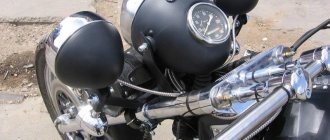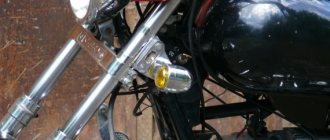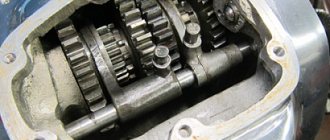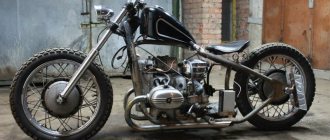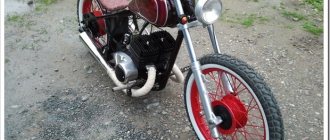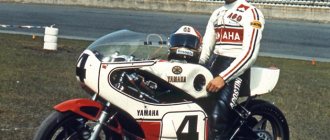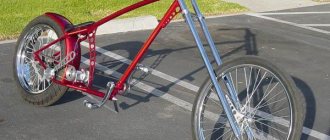Russian motorcyclesUral motorcycles
For a very long time, the domestic motor industry did not have a significant variety of models.
And although the design of motorcycles was constantly improved, the concept of all models remained unchanged.
It was a classic for domestic motorcycles. The concept was dictated by the need for versatility of models and the use of motorcycles as transport to solve many problems.
The first attempt to create an unusual bike for us was made by the Irbit Motorcycle Plant, which was engaged in the production of heavy all-terrain motorcycles under the Ural brand.
The emergence of the biker movement in the early 90s indicated a growing interest in chopper class motorcycles, which were not produced here.
And since there was interest, at least small-scale production of domestic “choppers” was required .
The first model of a domestic motorcycle with an American style was called “Ural Voyage”, and it appeared in 1996.
Of course, the designers were not very successful in creating a “chopper” in the American sense, but still the Voyage was a rather interesting model .
Design Features
The basis for the creation was the “Ural” classic model.
Most of the components were left unchanged, but some elements were used on the Ural for the first time .
Thus, the load-bearing part of the Voyage was a tubular frame with welded joints.
At the front, a duplex telescopic fork was installed as a suspension.
An 18-inch spoked wheel was supposed to give the “chopper” look at the front. For the first time, front disc brakes were installed on Voyage .
At the top of the fork there was a small round headlight.
The steering wheel is high, but the dashboard could not be placed on the tank , as is done on American choppers; it was installed above the headlights, and it protrudes somewhat forward.
The tank has a teardrop shape and is located at an angle. The seat, although covered in leather, did not particularly look like a “chopper” seat; rather, the seat was a so-called “bench”.
Behind the seat there was a backrest with a soft cushion . Under the seat there were pads that covered the frame and at the end formed the wing.
The rear suspension of the motorcycle is a classic pendulum with two shock absorbers. The rear wheel has wide-profile tires and measures 16 inches.
Do you want to buy a motorcycle video recorder? Here is information that will help you make your choice.
Review of one of the reliable types of motorcycle equipment:
The first models used drum brakes at the rear, but they were later replaced by disc brakes .
The Voyage was equipped with an opposed 4-stroke power unit with two cylinders. Moreover, at different times the power unit had a different working volume .
Initially, the motorcycle was equipped with a 720 cc engine, later – 650 cc and 825 cc engines.
The engine could be started using either a kickstarter or an electric starter - installed for the first time on Ural motorcycles.
The power system remained the same - carburetor, separate for each cylinder, but the carburetors were of Czech production .
The exhaust system was also revised. The pipes coming out of the cylinders went under the engine, and then came out on the sides and went up.
The gearbox is 4-speed and with reverse gear. Drive to the rear wheel is via a cardan transmission.
Transition from ZAZ to Dnepro
Many people today are interested in how to connect a MEMZ-968 engine to a gearbox from a heavy motorcycle.
Since I did this, I want to share my experience. I encountered this problem when building –BIGRED- and I think I dealt with it quite successfully.
In principle it’s quite simple, first I’ll tell you what it consists of. I took the housing from the MEMZ gearbox as a basis and cut it to a length of 51 mm from the mounting point to the engine. This operation can be done on a lathe, first cutting it with an allowance, after which a cover is cut out of a 14 mm thick duralumin plate using a jigsaw, following the contours of the cut, but with an allowance of 10 mm. Since the first body I came across was aluminum, I welded them.
But there are very few such MEMZ box cases; the second one had to be assembled with screws. I used M6 screws with an internal hexagon in the head. In the plate I made recesses for a head with a diameter of 7 mm and a depth of 6 mm, after which I cut threads in the casing (there is enough meat there) and pulled it off. 14 - 15 screws are enough for this. Next you need to open the hole for the MT box. This operation is also performed on a lathe. The casing-plate assembly is clamped in the chuck by the expansion groove for the fit on the engine and a hole is bored for the box (the bore and the seat for the box have the same center), after which holes are drilled for fastening the box; it is advisable to drill them in place with the clutch assembled. And yet, the hole for the box is made in plus + 0.5 mm - + 0.8 mm.
Now about the flywheel. I made the flywheel from two from MEMZ and MT - 10 is the simplest and most suitable option. I'll start with the MT-10 flywheel. First, the boss for the oil seal is cut off and the front part (the one towards the engine) is machined to a size of 44 mm from the top of the clutch mounting pins to the front part. Next, the central hole is bored to a diameter of 85 mm. Now we grind on the outside to a size of 225 mm.
Now the flywheel is MEMZ. In the center of the flywheel we make a lowering with a landing size of 225 mm - 0.04 and a depth of 5 mm.
Assembly takes place using a press. After the MT flywheel is pressed in, we drill holes for the coupling bolts through both flywheels and M10 thread mode (6 pcs.). Now the heads of the bolts on the MT flywheel are lowered so that they do not stick out), I used bolts with an internal hexagon in the heads). Then we tighten both flywheels with bolts, cut off and core the ones sticking out from the front side of the flywheel.
Now we check the structure for axial and diametrical runout. If everything is done correctly, then it shouldn't exist. You can also rebalance the structure, although there is not much difference. And you also need to check the size between the back of the MEMZ flywheel and the tops of the clutch mounting pins, it should be 39 mm!!!
Well, it's ready. We put the flywheel on the engine, center and assemble the clutch, put the adapter in place and install the gearbox, mark the place where the box is mounted, drill holes (4 pcs.), M8 thread mode, tighten the box.
ALL LET'S GO
Specifications
All data on the Ural Voyage is given in the table, but the characteristics of the model with a 720 cc engine are indicated there:
| Characteristics of the Ural Voyage motorcycle | ||
| Parameter | Unit change | Index |
| Length | mm | 2200 |
| Width | mm | 760 |
| Height | mm | 1300 |
| Ground clearance | mm | 145 |
| Engine | type | 2-cylinder, opposed |
| Working volume | cube cm. | 720 |
| Power | hp | 44 |
| Start date | type | kickstarter, email starter |
| S-ma nutrition | type | carburetor, 2 carb. |
| Transmission | type | mech., 4-speed |
| Drive unit | type | gimbal |
| Dry mass | kg | 225 |
| Maximum speed | km/h | 130 |
A number of reasons led to the cessation of production of the Ural Voyage, but it served as the basis for the creation of another model, which became the Ural Wolf motorcycle.
Biker clubs also took part in the design of the Wolf, which ensured that the new motorcycle was more similar to classic choppers.
Having taken the Voyage and reconsidered its appearance, the designers did not stop there.
The “Wolf” has a different power unit in terms of volume and power, although it is also opposed, and a slightly different exhaust system.
The front fork is further forward, which adds length to the motorcycle. The seat on the “Wolf” is no longer level, but stepped.
Custom motorcycle gas caps
A motorcycle gas tank cap is the easiest way to decorate your Ural and give it a stylish look. We manufacture a range of gas tank caps. Material aluminum alloy and brass.
Among them there are models that are compatible only with the Urals. There are also universal models. We make universal covers from brass and with a more complex design. Therefore they cost more than usual. They are highly valued in Europe and are often purchased for installation on Harley Davidson.
Conclusion
The Irbit Motorcycle Plant today is the only one that produces Ural motorcycles. It so happened that it outlived the factories that produced the Dnepr motorcycle (also a legendary domestic brand). However, production volumes these days are far from what they were before.
For the last ten years, approximately 1,200 pieces have been produced per year. The figure varies slightly, but not significantly. No more than five percent of the currently produced Ural motorcycles enter our market. Their price is comparable to a car.
And yet, nothing prevents our fans of this brand from finding old models, restoring them and tuning them. Therefore, if you were looking for an online store for the Ural motorcycle, take a look at our section with custom covers. We are sure you will like it there. We are located in Ukraine, but we deliver all over the world.
Estimated cost
Although production of the Ural Voyage was stopped, this motorcycle was still in little demand among us, so you can find it on the secondary market .
Now the cost for it ranges from 75 to 150 thousand rubles, depending on the technical condition of the motorcycle.
When purchasing a Ural Solo ST motorcycle, the buyer is offered the opportunity to order additional equipment for the model to upgrade the standard equipment.
The most significant thing in the design of this domestic moto was the appearance of a seat, which was popularly nicknamed “Bench”.
Voyage shafts in the 650cc Ural gearbox
Hello everyone.
I decided to put the 9th pair in the gearbox, but damn it, they are not on sale in the city, there are only 10ka for 1150 rubles and shafts for 1800. For such a price it’s scary to take a 10ka - IMHO stopudov ketai. But the shafts - they said in the store that they were from the voyage and were made by imz. I asked to count the teeth on the gears - 1st 36/10 2nd 31/15 3rd 28/18 4th 23/23 No matter how many times I searched on the Internet, Voyage ( ) did not have such shafts. The question is whether a regular 650cc Ural with an 8-wheel drive and 19″ wheels can handle it. Wouldn't it turn out that if you accelerated in 3rd, you turn on 4th and stop accelerating? such shafts were on the first voyages just with 8 and 650 m pihl, if my memory serves me correctly and the sources in which I read this. in fact, I don’t see any reason not to pull it) my friend and I had fun when we installed the 10th voyage box) it was fun to get going only with the throttle shifting like on a wolf with 3rd))) but it went smoothly, impressively - but we only dreamed of sudden lane changes and overtaking) and with 8 it will be much easier, but the gap between 3 and 4 is really big. on the 3rd engine you will turn it all the way - this has already been sucked here more than once
It will be normal to plug in a 9-unit mono, you just have to turn the engine in every gear to 4-5..
Hm. and I keep dreaming of putting the economic council shafts on the voyage box with 750 thrust on board.
and how many teeth are there on the economic council shafts?
according to the Internet (I don’t remember the numbers from memory) 1st 36/10 2nd 32/14 3rd 29/17 4th 26/20
I somehow assembled a “wolf” with 82 pistons, a gearbox with long gears, a 10-speed gearbox. It turned out very well. But the torque of the 650 and even the 750, not to mention the 825, is different. So the 650 It will be stupid to accelerate in 4th. You need 9th, you can try 8th.
In the fourth 1:1 725cc with nine it barely accelerates, in a straight line the maximum speed in fourth is slightly more than in third, in fact the fourth 1:1 with nine at 725cc turns into overdrive. On a 650cc with a fourth 1:1 with a nine it will only accelerate from a good hill, put a eight in the gearbox and it will go much better.
Ordinary voyages or from early voyages? IMHO the early gear ratios are not so tasty, it’s better then from the later voyages or from the wolf.
Maybe someone was misled by my question, I repeat, I wanted to know whether it would be possible to confidently accelerate in 4th gear after 3rd on a regular 650cc Ural with regular 19″ wheels and an 8th gear in the gearbox. The shafts in that store are exactly the ones I described, with exactly these gear ratios.
IGOREK, tell me, how much are the shafts? and especially 4 gears for a voyage in this store? And regarding your question, if you decide to change ALL the insides in the box, then IMHO the best option:
G.P. 8 (37/8) first standard (3.6) second standard (2.28) acceleration. 3 (Wolf 28/18) acceleration. 4 (Voyage 23/23)
1st gear - 3.6 2nd gear - 2.28 3rd gear - 1.56 4th gear - 1 G.P. – 4.62
1st gear*GP - 16.63 2nd gear*GP - 10.53 3rd gear*GP - 7.2 4th gear*GP - 4.62
Gear gaps Between 1 and 2 — 1.58 Between 2 and 3 — 1.46 Between 3 and 4 — 1.56
gaps within 50% The only thing I don’t know is how physically possible this is, I haven’t disassembled the box yet. I don’t know if it is possible to assemble in one box the 1st and 2nd gears of the Sovnarkhoz, the 3rd from the WOLF and the 4th (direct) from VOYAGE.
CaypoH1986, you see, the Ural gearbox does not allow you to “experiment” with gear ratios, because only the 4th gear gear can be replaced (removed from the input shaft), the remaining 3 gears are made together with the input shaft. Of course, the Dnepro gearbox has more freedom in changes (the 3rd and 4th gears are removed there). But, as already discussed, the Dnepro gearbox does not fit into the Ural M63 frame. I have two outputs - either 9ka or accelerated shafts. It’s just in this store, which is often seen selling used ones. parts, more or less restored. And it contains only these same shafts (I sense they were recently removed from some voyage and are available in a single copy) and 10ka for 1150, which is a little annoying (making such a transmission is quite labor-intensive). Indeed, I am afraid that after installing such shafts there will be a situation that nikll described.
Look, this is the method I want to apply to the Economic Council box: G.P. 9 (35/9) acceleration 4 (Wolf 25/21)
1st gear - 3.6 2nd gear - 2.28 3rd gear - 1.71 4th gear - 1.19 G.P. – 3.89
1st gear*GP - 14 2nd gear*GP - 8.87 3rd gear*GP - 6.65 4th gear*GP - 4.63
Gear gaps Between 1 and 2 — 1.58 Between 2 and 3 — 1.33 Between 3 and 4 — 1.43
The fourth turns out to be 1% slower than on the voyage with the 8th, but the gaps between gears are absolutely minuscule. Plus Volkovskaya acceleration 1.19, it’s easy to find.
the option that you propose (8ka, and the 4th direct from the voyage) G.P. 8 (37/8) acceleration 4 (Voyage 23/23)
1st gear - 3.6 2nd gear - 2.28 3rd gear - 1.71 4th gear - 1 G.P. – 4.62
1st gear*GP - 16.63 2nd gear*GP - 10.53 3rd gear*GP - 7.9 4th gear*GP - 4.62
Gear gaps Between 1 and 2 — 1.58 Between 2 and 3 — 1.33 Between 3 and 4 — 1.71
The gap between 3 and 4 is generally brutal. Therefore, you will have to brutally rev the engine in 3rd and then turn on 4th. Moreover, the plant seems to have not produced such gears for a long time.
tax, I repeat, the shafts that I want to purchase have a gear ratio of only the first gear like the original one, the rest are “accelerated” 1st - 3.6 2nd - 2.066 3rd - 1.566 4th - 1
Well, when will I purchase and install it (in the spring). You’ll have to turn it more in third, and oh well, in the city even third should be enough—practically, the Ural will have to accelerate to 100 km/h in third (but will there be enough power to spin it like that on a single driver). And along the highway, I think, there will be noise too. Well, if you suddenly don’t like it, it’s never too late to sell them here, because even one pair of gears from the 1:1 voyage costs 1 ruble.
Photo gallery
The selection includes the Ural Voyage, some of the owners made their own changes, while others chose to leave everything as it was in order to preserve it in its true form. Let's see what the models that have survived to this day look like.
